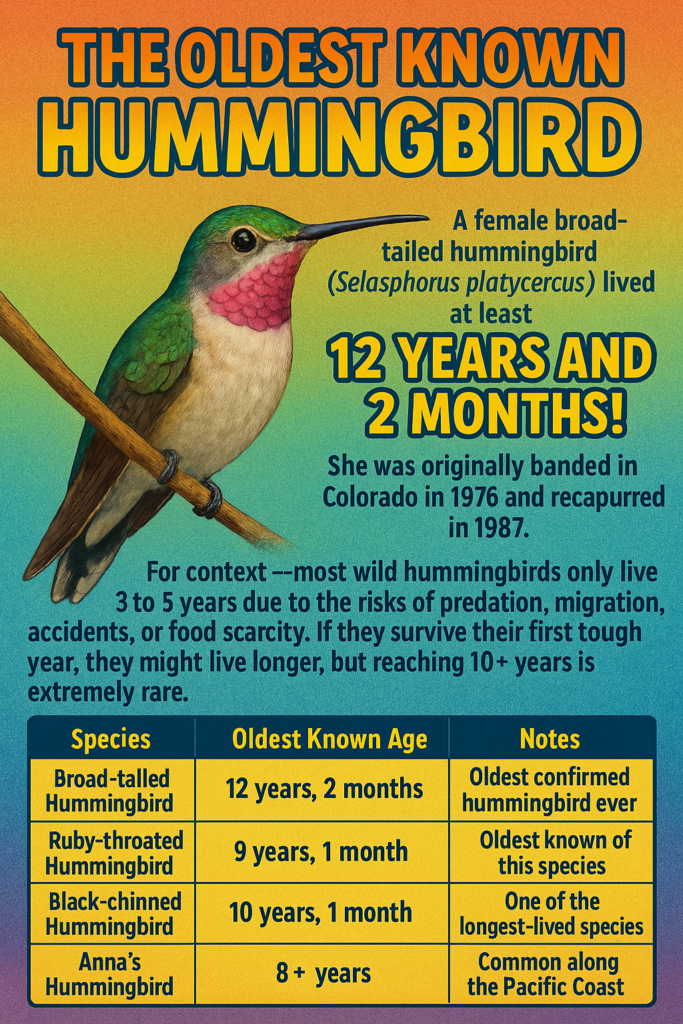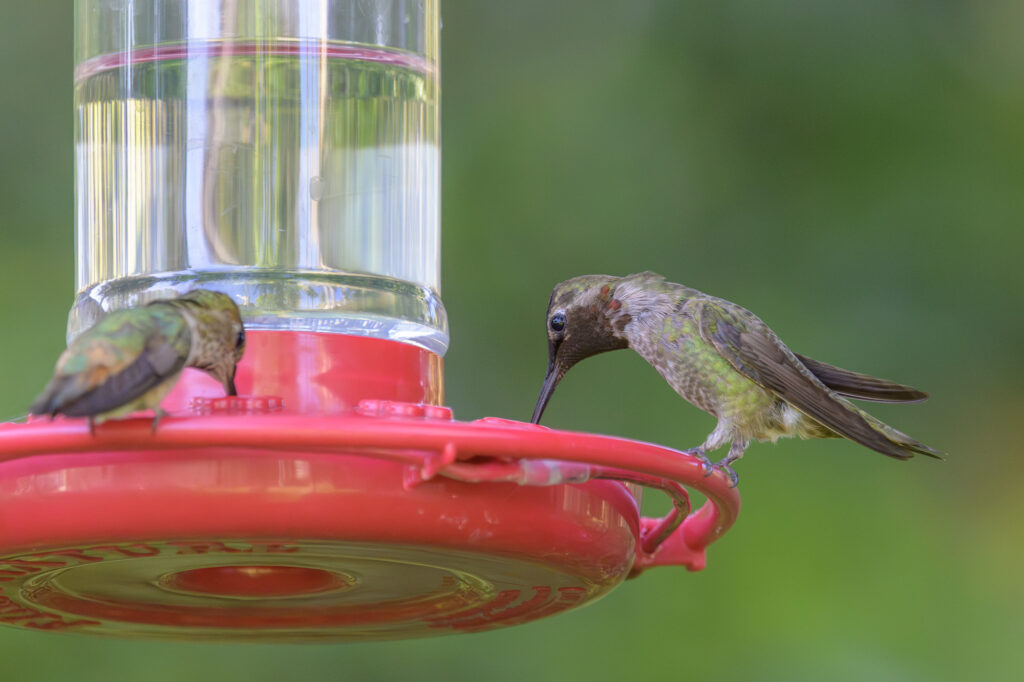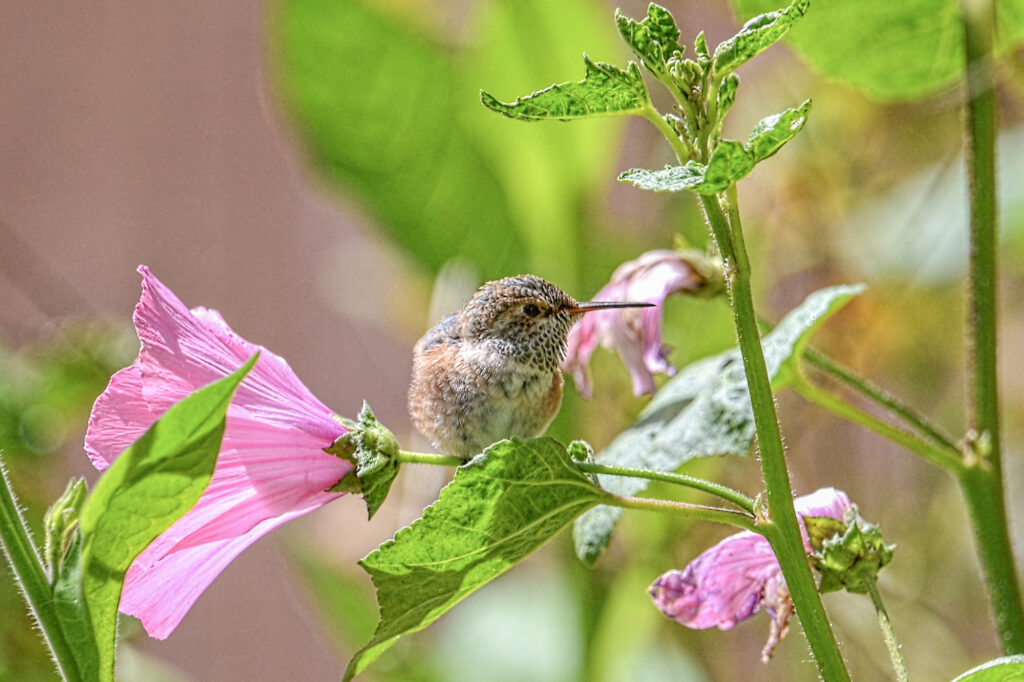How Long Do Hummingbirds Live?

The Oldest Known Hummingbirds
Three hummingbird species visit our yard: Allen’s hummingbirds, Anna’s hummingbirds and Black-chinned hummingbirds.
We also have a male Allen’s Anna’s hybrid. One of our longest residents is Olive, an Allen’s hummingbird.
Hummingbirds can live surprisingly long lives — especially for such tiny birds with incredibly fast heart rates and nonstop activity!
But their lifespan really depends on a few key factors like species, environment, and survival through their first year.
Oldest Known Hummingbirds

Average Hummingbird Lifespan (Wild Birds)

Why is the First Year So Risky?
Most hummingbirds that don't survive will die in their first year — mainly due to:
- Predators
- Lack of food
- Accidents (window strikes, getting trapped)
- Harsh weather
- Migration challenges
If a hummingbird can survive that first tough year, their chances of living several more years go way up!
Lifespan by Species (Examples)

What Helps Them Live Longer?
- Safe feeding stations (clean nectar, no pesticides)
- Natural habitat (native plants, shelter)
- Protection from predators (especially cats)
- Avoiding collisions (window decals, safe garden design)
- Reliable food during migration (flower gardens & feeders)
IMPORTANT NOTE: Hummingbird Life Expectancy — An Unanswered Question in Mexico and South America
While United States hummingbird species have been studied for decades — with banding records giving us insight into their maximum lifespans — much less is known about how long hummingbirds live in Mexico and South America.
South America is home to the greatest diversity of hummingbirds in the world, but life expectancy data is scarce or nonexistent for most species. Long-term banding studies, which help reveal survival rates and lifespan extremes, are limited outside of a few well-studied areas.
It's likely that some South American species live as long (or longer) than their Unites States relatives, but without the data, it's all just speculation.
For now, the lifespan of most tropical hummingbirds remains a mystery — waiting for future research to catch up.
What Factors Affect a Hummingbird’s Lifespan?
Predators
Hummingbirds are tiny — so they have lots of natural predators, including:
- Larger birds (hawks, jays)
- Snakes
- Praying mantises (yes, they’ll ambush hummingbirds at feeders!)
- Cats (especially outdoor or feral cats)
- Spiders (especially orb-weavers near feeders)
Accidents & Collisions
Big risks include:
- Window strikes (huge killer of hummingbirds)
- Getting trapped indoors
- Flying into cars, buildings, or other man-made obstacles
Food Availability
Hummingbirds need to eat constantly — their metabolism is sky-high. Things that affect their food supply:
- Habitat loss
- Lack of nectar-producing plants
- Poorly maintained feeders (moldy nectar is deadly)
Weather & Climate
Harsh weather can cut a life short:
- Extreme cold snaps during migration
- Drought (less flowers and insects)
- Storms or hurricanes along migration routes
Disease & Parasites
They’re vulnerable to:
- Fungal infections from dirty feeders
- Mites
- Internal parasites
- Avian pox or other viruses
Migration Stress
Migration is incredibly dangerous for hummingbirds:
- It’s exhausting — they can fly non-stop for hundreds of miles (like over the Gulf of Mexico!)
- They rely on stopover sites for food and shelter
- Habitat destruction along migratory routes puts them at risk
Genetics & Species Differences
Some species naturally live longer than others. In general:
- Average wild hummingbird lifespan: 3-5 years
- But if they survive their first year (which is the riskiest), they can live much longer
- The oldest recorded wild hummingbird lived over 9 years! (A female Broad-tailed Hummingbird)
Human Impact
Things like:
- Habitat destruction
- Pesticides
- Climate change All put extra pressure on hummingbird survival.
The Good News?
If you provide safe food, clean water, and habitat — you really increase their odds of living longer.
How You Can Help Hummingbirds?

Hummingbird Feeder
Provide Natural Food Sources
Plant native flowers rich in nectar — especially red, orange, and tubular-shaped ones. Some favorites:
- Bee balm
- Salvia
- Trumpet vine
- Cardinal flower
- Coral honeysuckle
- Fuchsia
Native plants are best because they support local ecosystems (and attract insects hummingbirds eat too!).
Set Up Clean Feeders
Supplement with sugar water:
- 1 part white sugar
- 4 parts water (No honey, dyes, or artificial sweeteners)
Clean the feeder at least twice a week — more often in hot weather — to prevent mold or fermentation, which can harm them.
Provide Fresh Water
Hummingbirds love misting and shallow water for bathing.
- A mister, small fountain, or dripper attracts them.
- Avoid deep birdbaths — they prefer moving water or fine spray.
Create Shelter
They need places to perch, hide, and nest:
- Leave small trees and shrubs.
- Avoid trimming everything to be too tidy.
- Native plants give them the right kind of cover.
Avoid Pesticides
Hummingbirds eat tiny insects for protein!
- No pesticides means more natural food for them (and it's safer for all wildlife).
Help During Migration
Migration is brutal for them. Extra feeders and blooming flowers in spring and fall give them the energy to keep going.
Be a Citizen Scientist
Participate in bird counts or submit sightings:
- eBird
- Journey North Hummingbird Migration Tracker
- Project FeederWatch
Data helps scientists understand hummingbird populations.
Be Mindful of Windows
Window strikes can kill hummingbirds. Use decals, screens, or other deterrents to help them see the glass.
Support Conservation Efforts
Donate to or volunteer with groups like:
- Audubon Society
- Cornell Lab of Ornithology
- The International Hummingbird Society
- Local native plant societies
Thank you so much for your incredible support. Everything we do here is made possible by the dedication of our volunteers and by your generous contributions. Your support helps offset ongoing expenses such as servers, cameras, network equipment, software, internet services, website maintenance, and more. Your continued generosity and encouragement truly mean the world to us. This is, without question, a labor of love for everyone involved. ❤️
Venmo @alyssasnaturesanctuary
Also check out Olives Online Store: https://alyssasnaturesanctuary.org/shop
And here is a link to things around Olive's Yard: https://amzn.to/4pTJ7ay

